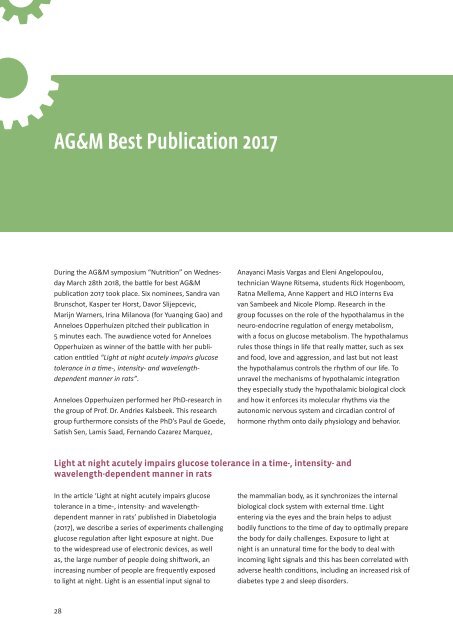AG&M annual report 2017
You also want an ePaper? Increase the reach of your titles
YUMPU automatically turns print PDFs into web optimized ePapers that Google loves.
AG&M Best Publication <strong>2017</strong><br />
During the AG&M symposium “Nutrition” on Wednesday<br />
March 28th 2018, the battle for best AG&M<br />
publication <strong>2017</strong> took place. Six nominees, Sandra van<br />
Brunschot, Kasper ter Horst, Davor Slijepcevic,<br />
Marijn Warners, Irina Milanova (for Yuanqing Gao) and<br />
Anneloes Opperhuizen pitched their publication in<br />
5 minutes each. The auwdience voted for Anneloes<br />
Opperhuizen as winner of the battle with her publication<br />
entitled “Light at night acutely impairs glucose<br />
tolerance in a time-, intensity- and wavelengthdependent<br />
manner in rats”.<br />
Anneloes Opperhuizen performed her PhD-research in<br />
the group of Prof. Dr. Andries Kalsbeek. This research<br />
group furthermore consists of the PhD’s Paul de Goede,<br />
Satish Sen, Lamis Saad, Fernando Cazarez Marquez,<br />
Anayanci Masis Vargas and Eleni Angelopoulou,<br />
technician Wayne Ritsema, students Rick Hogenboom,<br />
Ratna Mellema, Anne Kappert and HLO interns Eva<br />
van Sambeek and Nicole Plomp. Research in the<br />
group focusses on the role of the hypothalamus in the<br />
neuro-endocrine regulation of energy metabolism,<br />
with a focus on glucose metabolism. The hypothalamus<br />
rules those things in life that really matter, such as sex<br />
and food, love and aggression, and last but not least<br />
the hypothalamus controls the rhythm of our life. To<br />
unravel the mechanisms of hypothalamic integration<br />
they especially study the hypothalamic biological clock<br />
and how it enforces its molecular rhythms via the<br />
autonomic nervous system and circadian control of<br />
hormone rhythm onto daily physiology and behavior.<br />
Light at night acutely impairs glucose tolerance in a time-, intensity- and<br />
wavelength-dependent manner in rats<br />
In the article ‘Light at night acutely impairs glucose<br />
tolerance in a time-, intensity- and wavelengthdependent<br />
manner in rats’ published in Diabetologia<br />
(<strong>2017</strong>), we describe a series of experiments challenging<br />
glucose regulation after light exposure at night. Due<br />
to the widespread use of electronic devices, as well<br />
as, the large number of people doing shiftwork, an<br />
increasing number of people are frequently exposed<br />
to light at night. Light is an essential input signal to<br />
the mammalian body, as it synchronizes the internal<br />
biological clock system with external time. Light<br />
entering via the eyes and the brain helps to adjust<br />
bodily functions to the time of day to optimally prepare<br />
the body for daily challenges. Exposure to light at<br />
night is an unnatural time for the body to deal with<br />
incoming light signals and this has been correlated with<br />
adverse health conditions, including an increased risk of<br />
diabetes type 2 and sleep disorders.<br />
28



